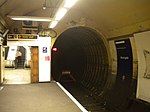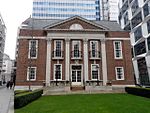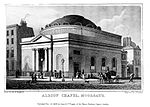The Moorgate tube crash occurred on 28 February 1975 at 8:46 am on the London Underground's Northern City Line; 43 people died and 74 were injured after a train failed to stop at the line's southern terminus, Moorgate station, and crashed into its end wall. It is considered the worst peacetime accident on the London Underground. No fault was found with the train, and the inquiry by the Department of the Environment concluded that the accident was caused by the actions of Leslie Newson, the 56-year-old driver.
The crash forced the first carriage into the roof of the tunnel at the front and back, but the middle remained on the trackbed; the 16-metre-long (52 ft) coach was crushed to 6.1 metres (20 ft). The second carriage was concertinaed at the front as it collided with the first, and the third rode over the rear of the second. The brakes were not applied and the dead man's handle was still depressed when the train crashed. The London Fire Brigade, Ambulance Service and City of London Police attended the scene. It took 13 hours to remove the injured, many of whom had to be cut free from the wreckage. With no services running into the adjoining platform to produce the piston effect pushing air into the station, ventilation was poor and temperatures in the tunnel rose to over 49 °C (120 °F). It took a further four days to extract the last body, that of Newson; his cab, normally 91 centimetres (3 ft) deep, had been crushed to 15 centimetres (6 in).
The post-mortem on Newson showed no medical reason to explain the crash. A cause has never been established, and theories include suicide, that he may have been distracted, or that he was affected by conditions such as transient global amnesia or akinesis with mutism. The subsequent inquest established that Newson had also inexplicably overshot platforms on the same route on two other occasions earlier in the week of the accident. Tests showed that Newson had a blood alcohol level of 80 mg/100 ml—the level at which one can be prosecuted for drink-driving, though the alcohol may have been produced by the natural decomposition process over four days at a high temperature.
In the aftermath of the crash, London Underground introduced a safety system that automatically stops a train when travelling too fast. This became known informally as Moorgate protection. Northern City Line services into Moorgate ended in October 1975 and British Rail services started in August 1976. After a long campaign by relatives of the dead, two memorials were unveiled near the station, one in July 2013 and one in February 2014.











